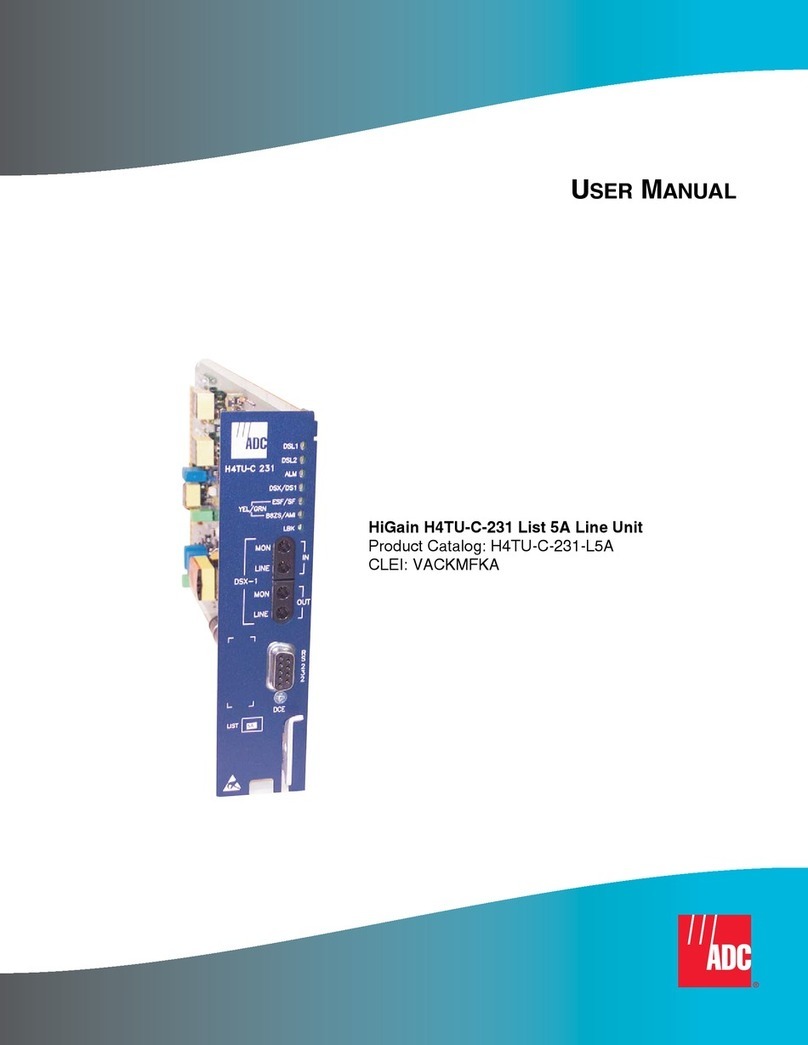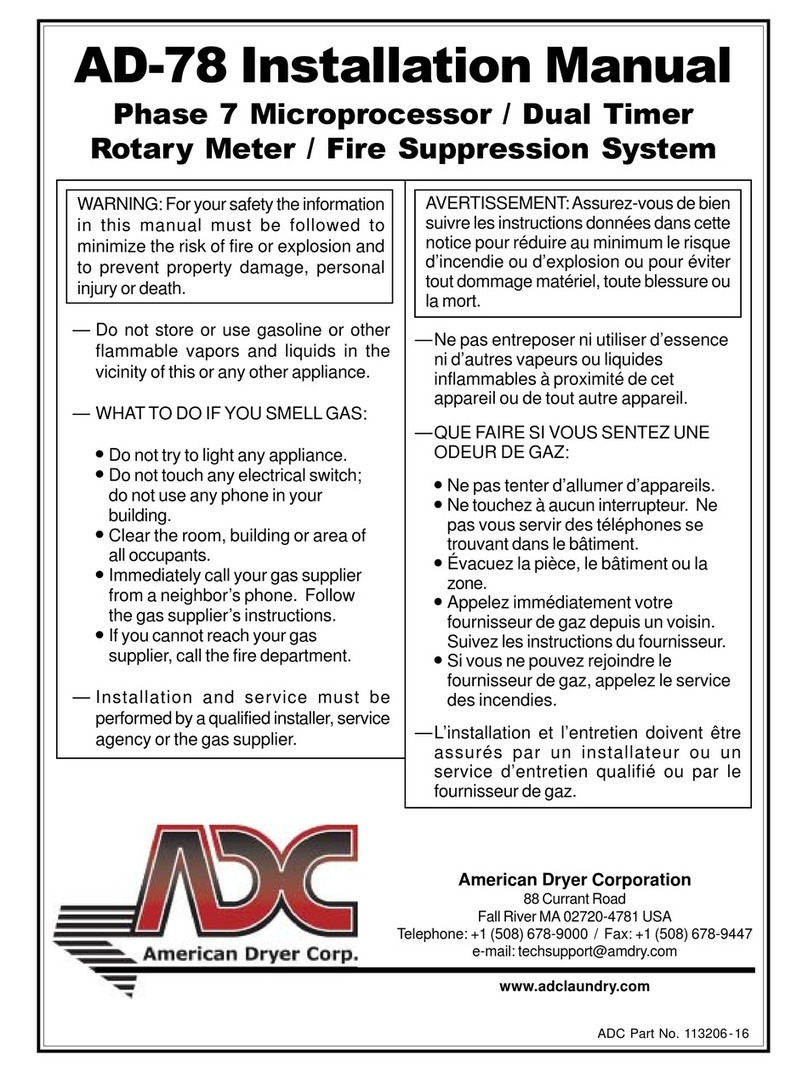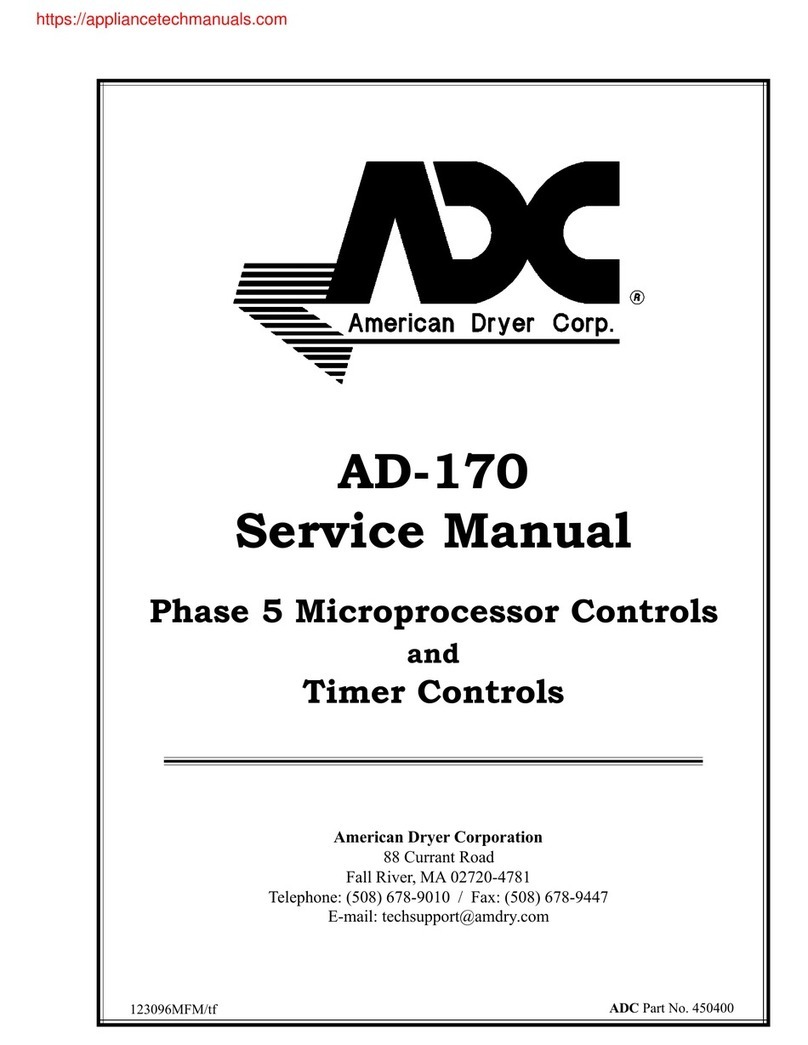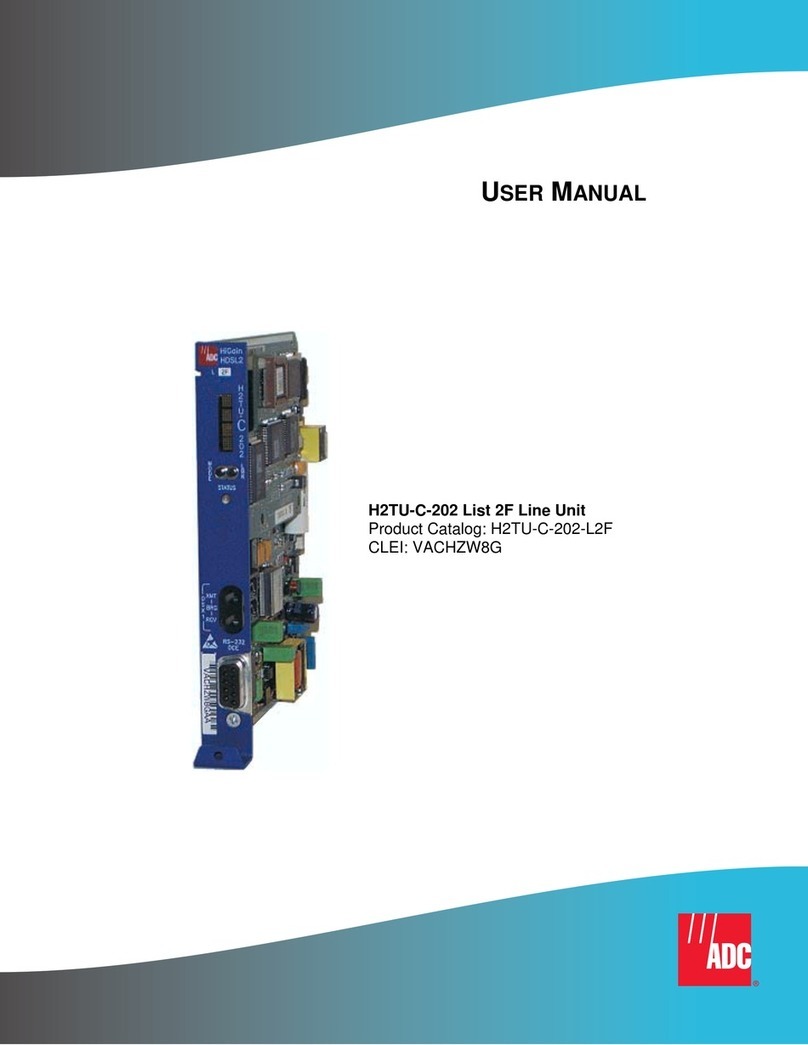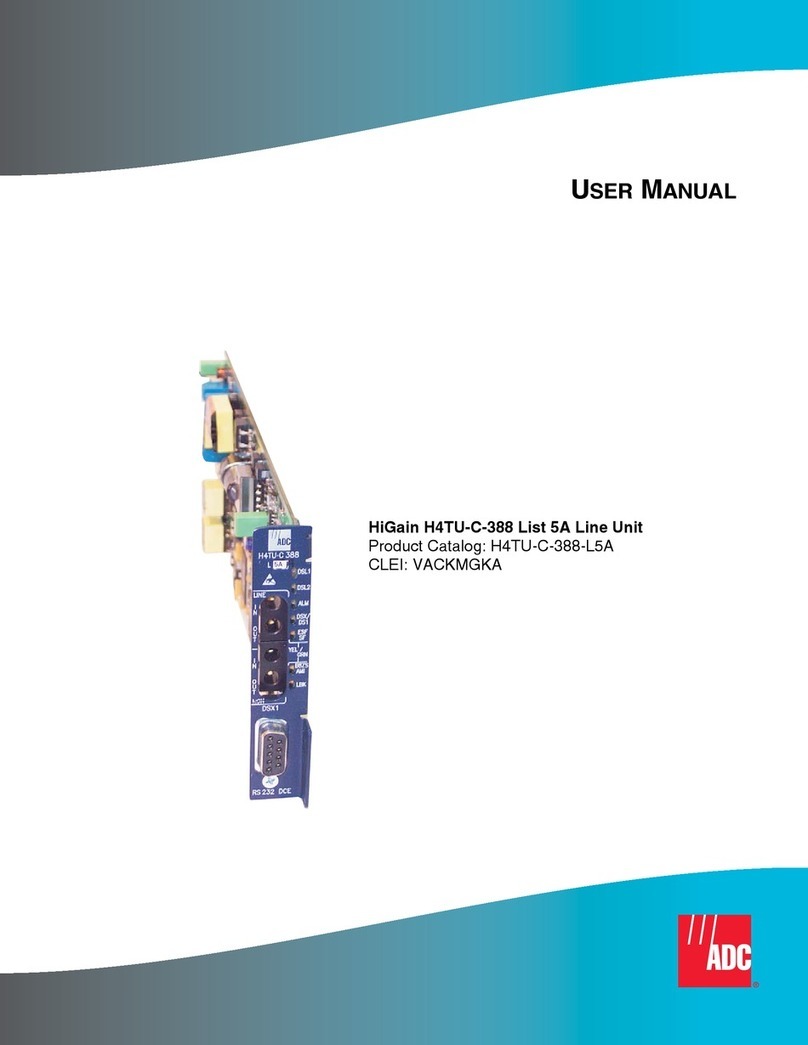
LOOPBACK TESTING
Initiate loopback testing from the maintenance menus or use the MODE and LBK
pushbuttons. The inband codes shown below can be sent by a test set.
Table 1. GNLB Loopback Commands
Loopback Inband Code Description
NLOC 1111000 DSX-1 signal is looped back to the network at the H2TU-C.
NREM 1110000 DSX-1 signal is looped back to the network at the H2TU-R.
COLB (a)
(a) Dual loopbacks are only initiated from the MODE and LBK pushbuttons.
DSX-1 signal is looped back to the network at the H2TU-C and signal from the
customer is looped back to the customer at the H2TU-C.
RULB (a) DSX-1 signal is looped back to the network at the H2TU-R and signal from the
customer is looped back to the customer at the H2TU-R.
CREM 1111110 DS1 signal from customer is looped back to the customer at the H2TU-C.
CLOC 1111100 DS1 signal from customer is looped back to the customer at the H2TU-R.
SMJK 11000 DSX-1 signal is looped back to the network at the H2TU-R SmartJack module.
Loopdown 11100 Deactivates any of the above loopbacks.
Table 2. Front-Panel Alarm Messages (a)
(a) Front-panel alarm messages are listed in order of priority. ALRM displays prior to any alarm message.
Pressing the LBK pushbutton initiates an Alarm Cutoff (ACO) message.
Message Description
PWR FEED SHRT (b)
(b) Message displays repeatedly as long as the alarm condition exists, and is not included in the priority order.
A short between the Tip and Ring of the HDSL2 pair.
PWR FEED GND (b) The HDSL2 loop is grounded.
PWR FEED OPEN (b) A line-power open condition.
LOSW The HDSL2 loop has lost synchronization.
LLOS No signal is detected at the DSX-1 input to the H2TU-C.
RLOS No signal is detected at the DS1 input to the H2TU-R.
LAIS (c)
(c) Does not activate the alarm relay access on pin H.
Line Alarm Indication Signal.
RAIS (c) Remote Alarm Indication Signal.
TRCI (c) An RAI alarm (yellow) from the Customer Premises Equipment (CPE) with an
error-free signal from the line unit or network.
RRAI(c) An RAI alarm (yellow) from the CPE with errors from the line unit or network.
xxx-DBER (c) A system DS1 Bit Error Rate (BER) alarm. (xxx denotes either Transmission Unit
Central Office [TUC] or Transmission Unit Remote End [TUR].)
PRMF (c) H2TU-R Performance Report Messaging BER threshold exceeded at far end.
PRMN (c) H2TU-R Performance Report Messaging BER threshold exceeded at near end.
xxx-HBER A system HDSL2 Block Error Rate (BER) alarm. (xxx denotes either TUC or TUR.)
xxx-MAL The margin on the HDSL2 loop has dropped below the threshold setting.
(xxx denotes either TUC or TUR.)
xxx-LA The attenuation on the HDSL2 loop has exceeded the maximum threshold value.
(xxx denotes either TUC or TUR.)
To comply with the intrabuilding wiring requirements of GR-1089
CORE, Section 4.5.9, the shields of the ABAM-type cables that
connect the line unit DSX-1 output ports to the cross-connect
panel must be grounded at both ends.
Network
H2TU-C H2TU-R
TLOS*
NLOC CREM CLOC
NREM
SMJK
* When enabled, TLOS is an automatic loopback
that occurs with an LOS at the remote DS1 input.
Downstream
Upstream
Customer
Premises
DS1
DSX-1
Table 3. Front-Panel Diagnostic Messages
Message (a)
(a) Normal operating messages are in bold.
Description
A=xx The Attenuation (A) message appears followed by xx, where xx is the highest loop
attenuation measured in dB.
ACQ The multiplexers of the H2TU-C and H2TU-R are trying to establish synchronization.
ARM Armed to respond to Intelligent Repeater Loop (ILR) codes.
BAD RT? The H2TU-C is not receiving a response from the H2TU-R.
FERR A framing bit error has occurred at H2TU-C DSX-1 input.
HES H2TU-C HDSL2 loop cyclical redundancy check (CRC) error.
LBPV A local bipolar violation has been received at the DSX-1 input to the H2TU-C.
M=xx Indicates the power of the received HDSL2 signal relative to noise (S/N with respect to
21.5 dB).
MNGD The H2TU-C is under control of the HMU-319 network management unit.
PWR FEED OFF HDSL2 span power is turned off.
PWR FEED ON HDSL2 loop is not grounded or shorted.
SIG The transceivers of the H2TU-C and H2TU-R are trying to establish contact with each
other over the HDSL2 loop.
Table 4. Front-Panel Read-Only Settings Using MODE(a)
(a) Front-panel codes scroll in the order listed. The configured selections follow each code.
Message Function (b)
(b) Default values are in bold.
VER x.xx Software version number of the H2TU-C.
LIST xx List number of the H2TU-C.
FRM xxxx Frame pattern received from the DSX-1 (SF, ESF, or UNFR).
CODE xxxx Line code (AMI or B8ZS).
LATT xx Loop attenuation threshold setting (38).
MARG xx Margin threshold setting (4).
EQL Sets the DSX-1 equalizer to: 0 (0 to 132 ft.), 133 (133 to 265 ft.),
266 (266 to 398 ft.), 399 (399 to 532 ft.), or 533 (533 to 655 ft.).
RLBO H2TU-R line buildout to DS1 is set to 0 dB, -7.5 dB, or -15 dB.
LPBK Enables (ENA) or disables (DIS) SmartJack loopback commands.
SPLB xxxx Configures system for generic (GNLB) or specialinband loopback commands (A1LB, A2LB, A3LB, A4LB, or
A5LB).
PWRF OFF = disables line power; ON =-180 Vdc.
HBER 1E-6 or 1E-7 = indicates HDSL2 BER alarm threshold setting. NONE = no generation of a system
alarm due to BER.
DBER Enables (ENA) or disables (DIS) fixed 24-hour DSX-1 BER alarm threshold.
LBTO Loopback timeout = NONE, 20 min, 60 min, 120 minutes, 8-hour, or 24-hour.
ALM Enables (ENA) or disables (DIS) alarm indications on pin H.
DS1 DSX-1 line code = B8ZS or AMI.
CONV H2TU-R frame format conversion = OFF (framing determined by the DS1 FRMG option),
ACON (autodetection of framing and potential frame conversion at the H2TU-R), or
FCON (autodetection of framing and forced frame format conversion at the H2TU-R).
FRMG DS1 frame formatting = AUTO (automatic framing) or UNFR (unframed).
RDA Enables (ENA) or disables (DIS) alarm indications due to remote DS1 LOS at H2TU-R input.
ALMP Enables system to output an alarm pattern: Alarm Indication Signal (AIS) or Loss of Signal (LOS).
BPVT Enables (ENA) or disables (DIS) Bipolar Violation Transparency.
NLBP Enables the H2TU-R to transmit either AIS or LOS towards CI for any network loopback.
TLOS Enables (ENA) or disables (DIS) a logic loopback at the H2TU-R when an LOS occurs at its DS1 input.
PRM OFF = no enhanced Performance Report Messaging; SPRM = Supplemental PRM;
NPRM = Network PRM; AUTO = SPRM + NPRM.
NAIS If ALMP is set to AIS, this option specifies which pattern is sent to the network when a remote LOS
or AIS occurs. CI = AIS-CI sent to the network; AIS = AIS sent to the network.
ROVR Enables (ENA) or disables (DIS) conversion of an ESF DS1 payload from the network with an
embedded RAI pattern to an SF-RAI pattern towards the CI at the H2TU-R. CONV option must be
set to FCON or ACON.
RACI Enables (ENA) or disables (DIS) conversion of a DS1 SF-RAI signal received by the H2TU-R to an
SF-RAI-CI signal towards the network.
PBON Configures the power output levels of the H2TU-C network unit toward the customer to comply with
Default (DEF) or Enhanced (ENH) templates.
PBOC Configures the power output levels of the H2TU-R customer unit toward the network to comply with
Default (DEF) or Enhanced (ENH) templates.
Copies of this publication or the user manual (LTPH-UM-1144-xx)
can be downloaded from the ADC website at www.adc.com. To
order a hard copy, please contact your sales representative.
Four-character display
DSX-1 access jacks
List number
Status LED
Displays status, provisioning, and
alarm messages. See table below
for a list of message descriptions.
Connect standard test equipment.
Craft port
To access all system maintenance, provisioning
and performance screens, connect a standard
9-pin terminal cable between the serial port
on a PC and the H2TU-C craft port.
LINE Provides splitting jack access to
(XMT) and from (RCV) the HDSL2 span
at the DSX-1 interface.
BRG Provides non-intrusive bridging jack
access to (XMT) and from (RCV) the
HDSL2 span at the DSX-1 interface.
Allows monitoring of the T1 payloads.
MaintenanceTerminal Modem Settings
L
B
K
M
O
D
E
R
C
V
X
M
T
B
R
G
B
R
G
L
I
N
E
L
I
N
E
H
2
T
U
*
C
3
1
9
R
S
2
3
2
SETUP
STATUS
Front Panel
A Customer Remote (CREM)
loopback or a Network Local
(NLOC) loopback is in effect.
Green LED Normal operation.
HDSL2 acquisition or
system alarm.
Red LED Fuse alarm.
Flashing Red LED
Yellow LED
FlashingYellow LED System is in Armed (ARM)
mode.
Off Line power is off.
HiGain
HDSL2
L
DCE
Card-Edge Connector
3
4
5
6
C
D
E
F
H7
8
J
9
K
10
L
GND
HDSL2SpanTip HDSL2SpanRing
SystemAlarm** ManagementBus**
Frame GND -48Vdc BAT
Fuse Alarm*
Factory burn-in
(Donotuse)
1
A
(XMT)DSX-1TXTip DSX-1TXRing(XMT)
2
B
(RCV)DSX-1 RCVTip1 DSX-1RCVRing1(RCV)
Fuse Alarm
System Alarm and Management Bus (reserved)
Normal = Floating (0 to -60 Vdc maximum)
Activated = -48Vdc, 10 mA maximum
*
**
Handle
(CLEI code and ECI bar code label on outside of handle)
9600 baud
8 data bits
No parity
1 stop bit
Hardware flow control:OFF
Terminal emulation:VT100
Use the MODE and LBK pushbuttons to review all system
parameters, including user-configured settings, and to
activate loopbacks.
Press
for at least 3 seconds to place the front-panel display in
scroll mode.When it has finished scrolling through all the
system parameters, the display returns to its normal mode.
To display system parameters:
To initiate a manual loopback:
1
MODE
Press LBK for more than
3 seconds to activate the NLOC and CREM loopbacks.
If a loopback condition already exists, this will loopdown all
existing loopbacks. Press LBK again for more than
3 seconds to reactivate the dual loopback.
Simultaneously press MODE and LBK for at least
3 seconds.The following message appears:
Press LBK to activate the NLOC loopback
or press MODE to advance to the next loopback
(NREM, CLOC, CREM, COLB or RULB).
, simultaneously
press MODE and LBK for 3 or more seconds.
To initiate a dual loopback:
MAN LPBK NLO?
2
To manually terminate a loopback
MODE and LBK pushbutton options












